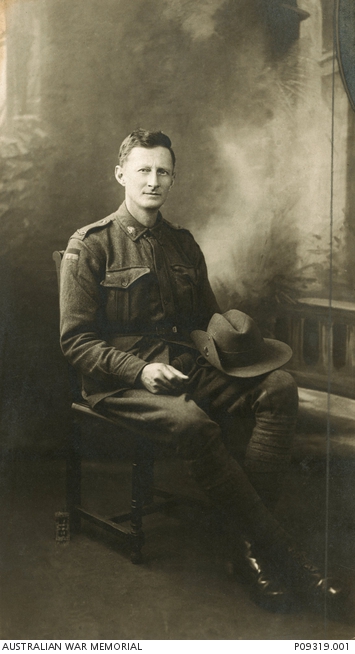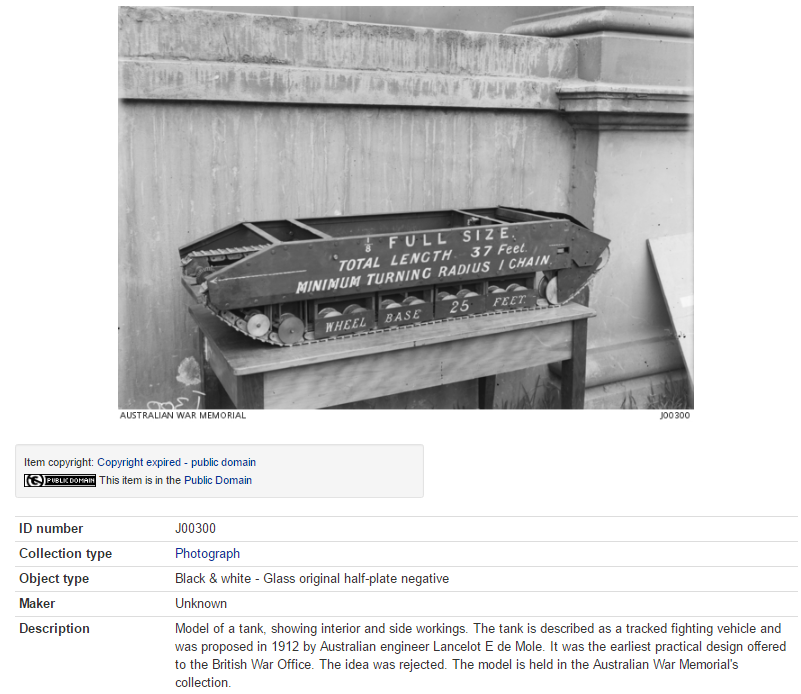de Mole, Lancelot Eldin
Imagine having an exceptional mind, and an intelligence, that leads to an invention strongly desired by just about every nation on earth. Imagine this invention that, even to this present day, is still very much in use. Imagine the income that should be derived from such an invention. Now imagine that event not coming to fruition, through a lack of understanding, and poor administration, of the people who were to assess your invention, not once, but three times. Such was the sorry tale of Corporal Lancelot de Mole, an engineer from Adelaide, who is now, belatedly, credited with the invention of the Army Tank.

Lancelot Eldin de Mole was born in Adelaide March 13th 1880. He was the son of William Frederick de Mole and Emily nee Moulden. He was a cousin to the Lord Mayor of Adelaide, F.B. Moulden. His father was an engineer, and he was to follow in his father’s footsteps.1
In 1911 whilst working as a civil engineer in Western Australia, Lancelot was having difficulty with his construction vehicles, getting bogged in sand. So he put his mind to the construction, of what we now call, a caterpillar tracked vehicle. It was then known as a chain rail vehicle. 2 So he invented a vehicle that would not bog in sandy or muddy terrain. Using his draughtsman skills he put the idea on paper. He realized that this vehicle could be used in a time of war, it could be armor plated, and fitted with guns. It had the ability to cross ditches and trenches. He described it as a mobile fort. Lancelot sent his design to the British War Office. They politely rejected his design, as there was no need for such a machine at that time, and his plans were pigeonholed.3 Friends advised him to take his design to the German Consul in Perth. He declined as he thought Germany could become an enemy at some later date. With the outbreak of war in 1914 he set about redesigning his mobile fort and again forwarded it to the British War office in 1915.4 In the meantime he had applied to join the army and was rejected a number of times due to his poor health. The British war office received his latest design and requested a working model. So he had a working model, constructed, by borrowing the funds, from a friend.5

In 1916, he again tried to enlist in the army, and once more was refused. By September 1917, Lancelot Eldin de Mole was passed as fit to join the AIF. The one eighth size model of his mobile fort was nearing completion. He joined Lieutenant Harold Leslie Boyce’s 10th Battalion. Lieutenant Boyce was aware of his invention and agreed to help in any way possible, to get his model shown to the British Inventions Committee. 6 They liked what they saw and recommended it to the Tank Board, or Land ships Committee as it was known. The name Tank was the name given to the vehicle that they were trying to build. To keep it a secret, it was described as a water carrying tank.They wanted anyone, not in the know, to believe it was an all terrain vehicle for carrying water across rough ground. That is why it was called a Tank. 7Lancelot de Mole’s model was misplaced, somewhere between the Inventions Committee and the Tank Board. It was missing for six weeks, and he did not get a chance to demonstrate it to the Board. In the mean time he along with his battalion, where called to fight in France, in March 1918. While fighting in France Lancelot, and his commanding Officers, were able to see at first hand, the British designed Tank. All agreed it was inferior to that designed by Corporal de Mole. The British Tank could not turn, and could not reverse. 8Corporal de Mole’s design had a turning mechanism that allowed it to turn around in a distance of one chain. (Approx. 20 Metres)
(Plan of the Mobile Fort by Lancelot de Mole plan courtesy of http://net.lib.byu.edu/estu/wwi/comment/DeMole/designnotpassedon.htm)
It could also climb over obstacles either going forward or in reverse. The de Mole Tank had sloping tracks front and rear. The British design had sloping tracks at the front and flat tracks at the rear. As it could not reverse, it was not thought to need a sloping track at the rear. After the war ended, Corporal de Mole returned to London. He was encouraged to seek compensation for his Tank design through a British Royal Commission on Inventions, set up after the war, to award persons who had helped with innovations, used during hostilities. The Royal Commission found that the Tank built for war, by Britain, was in no part designed by Corporal de Mole, therefore he could not be awarded any compensation. They did however agree that his design was superior to that used. 9 The rewards for the Tank had been awarded to the individuals who had designed the model that Britain had manufactured and used in the war. One of whom was a Major Wilson who received £7,500 and was the same person who had rejected Corporal de Mole’s plan in 1912.10 The Royal Commission went on to state, that they had designed an inferior vehicle, unaware that a better design was within their keeping.
The War Office, decided to award Corporal de Mole £985, for expenses incurred in the manufacture of his model Tank. In 1920, Lancelot Eldin de Mole was awarded a Commander of the British Empire (C.B.E.) 11
After a long illness he died in N.S.W. on the 6th of May 1950.
(The Mark I British Tank Photo courtesy of Wikipedia)
The British Tank constructed in 1916, and considered by the Royal Commission for compensation, as inferior to that which had been designed by Lancelot de Mole.
Researched and compiled by Jim Nelson, a volunteer with the Campbelltown Library “Digital Diggers” group.
If you have any comments or questions regarding the information in this local history article, please contact the Local History officer on 8366 9357 or hthiselton@campbelltown.sa.gov.au
References
- Chris Clark, 'de Mole, Lancelot Eldin (1880–1950)', Australian Dictionary of Biography, National Centre of Biography, Australian National University, http://adb.anu.edu.au/biography/de-mole-lancelot-eldin-5950/text10149, published first in hardcopy 1981, accessed online 23 March 2017.
- 1919 'CHAIN-RAIL TANK', Examiner (Launceston, Tas. : 1900 - 1954), 23 October, p. 5. (DAILY), viewed 23 Mar 2017, http://nla.gov.au/nla.news-article51058343
- 1921 'RENMARK AND DISTRICT.', Murray Pioneer and Australian River Record (Renmark, SA : 1913 - 1942), 12 August, p. 17. , viewed 23 Mar 2017, http://nla.gov.au/nla.news-article124816967
- 1924 'TALE OF THE TANKS.', Western Mail (Perth, WA : 1885 - 1954), 14 August, p. 29. , viewed 23 Mar 2017, http://nla.gov.au/nla.news-article37627874
- 1919 'DE MOLE'S TANK', Evening News (Sydney, NSW : 1869 - 1931), 12 November, p. 1. , viewed 23 Mar 2017, http://nla.gov.au/nla.news-article115869410
- 1919 'DE MOLE'S TANK.', The Richmond River Express and Casino Kyogle Advertiser (NSW : 1904 - 1929), 21 November, p. 6. , viewed 23 Mar 2017, http://nla.gov.au/nla.news-article120242394
- "Tank". En.wikipedia.org. N.p., 2017. Web. 23 Mar. 2017. https: //en.wikipedia.org/wiki/Tank#Etymology
- 1921 'RENMARK AND DISTRICT.', Murray Pioneer and Australian River Record (Renmark, SA : 1913 - 1942), 12 August, p. 17. , viewed 23 Mar 2017, http://nla.gov.au/nla.news-article124816967
- Chris Clark, 'de Mole, Lancelot Eldin (1880–1950)', Australian Dictionary of Biography, National Centre of Biography, Australian National University, http://adb.anu.edu.au/biography/de-mole-lancelot-eldin-5950/text10149, published first in hardcopy 1981, accessed online 23 March 2017.
- 1921 'UNLUCKY DE MOLE,', The Daily News (Perth, WA : 1882 - 1950), 11 February, p. 1. (THIRD EDITION), viewed 23 Mar 2017, http://nla.gov.au/nla.news-article79401708
- Chris Clark, 'de Mole, Lancelot Eldin (1880–1950)', Australian Dictionary of Biography, National Centre of Biography, Australian National University, http://adb.anu.edu.au/biography/de-mole-lancelot-eldin-5950/text10149, published first in hardcopy 1981, accessed online 23 March 2017.
